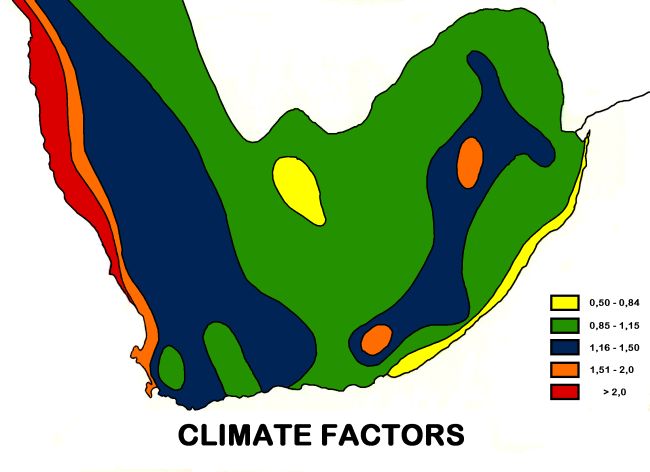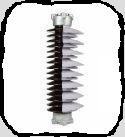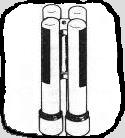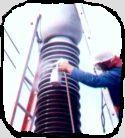INSULATOR
POLLUTION SERVICES
INTRODUCTION
The team at Mace Technologies specialise in the investigation and elimination of pollution flashovers on high voltage, outdoor insulators. Experienced in the analysis and treatment of systems from 6,6kVAC to 400kVAC and 533kVDC, they are well placed to solve insulator contamination problems in the most practical and cost-effective manner.
The engineer responsible for such projects, Roy Macey, commenced study of the insulator pollution problem at the University of Cape Town in 1971 and, as a researcher with Eskom’s Electrical Research Division, an insulator designer with the Cullinan Group and a consultant to utilities, now has 30 years experience in this field. He holds an MSc(Eng) degree for his thesis on this subject and his paper “The performance of outdoor insulation in contaminated environments” gained a South African Transport Services Award. In 1987 he won the Telemecanique Electrical Design Award and the Design Institute/Shell Design Award for his 22kV overhead line insulation system. He has served on numerous South African Bureau of Standards Specification Committees, National Energy Council Steering Groups, High Voltage Coordinating Committee Working Groups, the Executive Board and Technical Board of the SA National Committee of Cigre and is a member of the Cigre Working Group 22-03 on insulators. In 1996, he was elected as South Africa’s representative on Cigre Study Committee 22 “Overhead Lines”. He has delivered numerous papers and lectures on insulator pollution in South Africa, the United States of America, Peru, Australia and New Zealand.
This document serves to describe the activities, equipment, materials and components offered to electrical utilities to prevent the breakdown of high voltage insulation under contaminated conditions.
POLLUTION SEVERITY SURVEYS
In addressing insulator pollution problems, the first step is to fully define the contamination levels and present at the site and the range of environmental conditions under which the equipment must operate. Mace Technologies offer comprehensive pollution severity surveys incorporating:
· The measurement of the pollution level utilising directional Dust Deposit Gauges to establish the “Pollution Index” of the site
· The undertaking of “equivalent salt deposit density (ESDD) and “non-soluble deposit density” NSDD measurements to supplement the dust deposit gauge results
· The study of the current and historic performance of the insulators on site and at sites nearby. Where considered justified, on-line leakage current recording on existing insulators may be undertaken
· The investigation of the various sources of pollution in the area to define the nature of the contamination and its possible variations and effects on insulation
· The interviewing of site personnel and examination of records to assess the experiences, observations, corrective actions attempted, etc.
· The study of meteorological data pertaining to the site in question.
As an example, the image below depicts the results of an analysis of climatic conditions for South Africa, in particular the probability of washing by rain and wetting by fog. This information can be used in conjunction with the Dust Deposit Gauge results, to more accurately define the pollution severity of a particular site.

On conclusion, the output of the above programme facilitates the selection of the optimum corrective action to be employed and/or permits the proper design of new insulation better suited to the ambient conditions, with a view to providing a secure, maintenance-free system.
INSULATOR AUDITS
For existing installations, Mace Technologies undertake detailed audits of the insulators on site. Such audits include an assessment of the condition of the insulators and their physical and electrical characteristics. The critical geometric parameters – such as shed diameter, shed spacing, shed spacing-to-projection ratios, creepage distance, etc. - of every type of insulator on the line and/or in the substation are recorded.
The results of the Insulator Audit combined with those of the Pollution Severity Survey permit the development of strategies to prevent future outages. Such strategies may comprise the replacement of the insulators, the introduction of particular maintenance procedures or the upgrading of the insulation to minimise the risk of flashover.
INSULATOR SPECIFICATION & DESIGN
Insulator maintenance procedures tend to be costly in the long term and, when pollution problems are experienced, the replacement of the insulator with one designed to permanently accommodate the ambient conditions usually represents the most economic solution.
For new lines and substations, it is most important to select the appropriate insulation at the design stage.
Based on the Pollution Severity Survey and, for existing installations, the Insulator Audit, Mace Technologies will define the insulator specifications necessary to ensure reliable operation. This service can be extended to the supply and installation of the insulators if required.
INSULATOR COATING
Where the insulators cannot be practically replaced, such as in substations with their variety of supports, housings and bushings which are an integral part of existing apparatus, other techniques must be considered. Of these, the application of a room-temperature-vulcanised (rtv) silicone rubber coating is often the most attractive approach in both engineering and economic terms.
The coating provides the insulators with an extremely hydrophobic surface, preventing the formation of a continuous, wet, conducting contaminating layer. Even when dirty, the low molecular weight silanes present in the material diffuse into the pollution making it water-repellent without, as is the case with grease coatings, causing it to adhere to the surface. The effectiveness of silicone rubber in eliminating pollution flashover has been well proven in the most extreme environments.
Although having a slightly higher initial cost than greasing (20-25%), with the longer life of the silicone rubber coating, considerable savings are realised – over 30 years, greasing costs are approximately eight times that of coating. Being very site and insulator specific, the actual coating life will vary but, in areas of heavy pollution severity, a period of at least 7 to 10 years of satisfactory operation can be expected.
As the highly water-repellent coating surface causes any moisture to bead up and run off, leaving the insulator largely dry, it serves to prevent flashover under both “pre-deposited” and “instantaneous polluting conductive fog” conditions.
Mace undertake the silicone rubber coating of insulators with their Insilcote HV2000 material. Insilcote is the result of a joint development project between Mace Technologies and the Electric Power Research Group of the University of the Witwatersrand. It has been effectively used in the most harsh environments since its introduction in 1991. Further details of the material can be found in the Insilcote section.
INSULATOR UPGRADING
Silicone rubber coating provides a vast improvement to insulator performance and in many cases will, on its own, represent a permanent solution to pollution flashover. The reliability of any substation, however, is dependent on the weakest insulator in the yard. For those units which are grossly under-dimensioned for the prevailing conditions, the application of custom-designed shed extenders prior to coating, ensures that all insulators are of adequate standard. This complete upgrading system, named Insilcure, is unique to Mace Technologies.
Based on the Pollution Severity Survey and the Insulator Audit, the design of the silicone rubber shed extenders to achieve the required increase in creepage distance, whilst maintaining an acceptable or enhanced profile, followed by the silicone rubber coating of the entire insulator to create a uniform hydrophobic surface, can yield a performance improvement to accommodate the most extreme environmental conditions. Moreover, the correct dimensioning of the profile ensures that the coating is not over-stressed, making its life practically indefinite.
For further information, refer to the Insilcure section.
CONCLUSIONS
With the often serious consequences of insulator flashover, the unreliability and limited effectiveness of washing programmes and the high economic and environmental costs of greasing, more permanent solutions to pollution problems must be established. This requires detailed knowledge of both the site conditions and the insulator characteristics.
The Pollution Severity Survey, Insulator Audit, Insulator Design, Silicone Rubber Coating and Insulator Upgrading services of Mace Technologies have been developed to provide reliable, maintenance-free insulation, significantly enhancing system security in highly polluted areas.

INSILCURE
HAWKEYE
REDEYE
COND JOINTS


